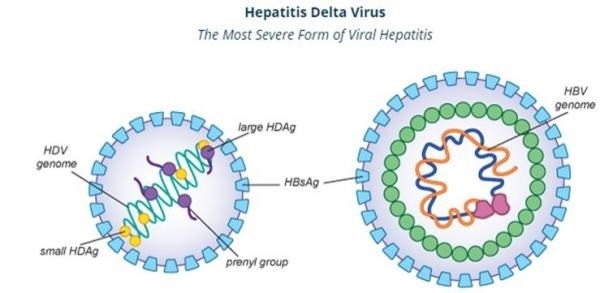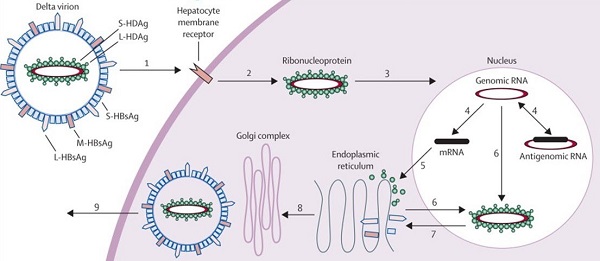Hepatitis D virus - Classification, Morphology, Replication, Transmission, Pathogenesis, Lab diagnosis
Classification of Hepatitis D virus
The classification of the Hepatitis D virus is done:
Realm: Ribozyviria
Family: Kolmioviridae
Genus: Deltavirus
The Deltavirus genome contains species:
Deltavirus cameroonense [HDV-7]
Deltavirus carense [HDV-6]
Deltavirus italiense [HDV-1]
Deltavirus japanense [HDV-2]
Deltavirus peruense [HDV-3]
Deltavirus senegalense [HDV-8]
Deltavirus taiwanense [HDV-4]
Deltavirus togense [HDV-5]
Hepatitis D virus is an incomplete virus and requires the presence of HBV to replicate and infect other hepatocytes. Hence, HDV infection occurs only in patients who suffer from HBV infection.

Fog: HDV morphology (left), HBV morphology (Source: Slideshare)
Morphology of Hepatitis D virus
The Hepatitis D virus is spherical, enveloped (85nm in diameter), and single-stranded negative RNA of 17 kb size.
The single-stranded RNA is circular and is surrounded by a delta-antigen core which in turn is surrounded by an envelope that contains HBsAg. Delta Ag occurs in 2 sizes-small (24KDa) or large (26KDa). Delta Ag is the only protein coded for Hepatitis D virus RNA that is distinct from antigenic determinants of HBV.
Replication of Hepatitis D virus
Replication occurs in the liver, causing liver damage and cytotoxicity. The damage is caused as a result of direct cytopathic effect in combination with underlying immunopathology of HBV disease
Although the Hepatitis D virus can replicate independently within the hepatocytes, it requires HbsAgfor its propagation.

Fig: HDV replication (ResearchGate)
Transmission of Hepatitis D virus
Hepatitis D virus is a blood pathogen and is transmitted by blood and vaginal secretions. Transmission routes include:
non-percutaneous route (close intimate contact)
contaminated blood and blood products
Sharing of contaminated needles among IV drug users
sex
perinatal
Pathogenesis of Hepatitis D virus
The incubation period of the Hepatitis D virus is 21-45 days but may be shorter in case of superinfection. The clinical course may range from acute-self-limited infection to acute fulfillment of liver failure. Clinically, Hepatitis D virus infection is indistinguishable from other forms of viral hepatitis.
Patients with both Hepatitis B virus and Hepatitis D virus infection show a more severe course of disease than patients with HBV infection alone. Only 1% of patients with coinfection progress to develop fulfillment hepatitis resulting in more rapid progression to cirrhosis.
Lab diagnosis of Hepatitis D virus
The laboratory diagnosis of Hepatitis D virus is as follows:
Specimen
Blood (serum)
Serological
ELISA is one of the serological tests used for diagnosis of Hepatitis D virus.
IgM ELISA is used to detect anti-HDV IgM during the early stage of infection
IgG ELISA for anti-HDV IgG is used during the later course of infection
Molecular
- Reverse Transcriptase PCR (RT-PCR) detects Hepatitis D virus RNA in blood in the stage of co-infection
*In superinfections, a high level of both IgM and IgGAb, as well as a high level of HDAg and Hepatitis D virus RNA, is demonstrated.